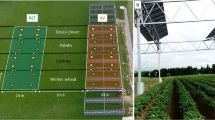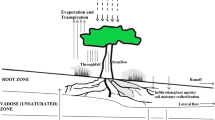Abstract
The objective of the present study was to develop a simulation model of the growth of sweet orange (Citrus sinensis L. Osbeck) cv. Natal in response to climate change based on system dynamics principles. The model was developed based on a system analysis of the factors that affect crop biomass formation. The main variables considered were atmospheric carbon dioxide (CO2), air temperature, transpiration, rainfall, water deficit, irrigation depth, canopy volume, and the respective interrelationships. Simulations were performed for the period from 2010 to 2100. Overall, the model results indicate that the increase in atmospheric CO2 concentrations predicted in the Intergovernmental Panel on Climate Change (IPCC) report, combined with air temperatures higher, lower, or equal to those generally occurring in natural environments, will result in higher water use efficiency by orange trees. When other factors, such as the soil water deficit, were included in the model, the water productivity was predicted to be lower in 2100 without irrigation than when irrigation was included. It is concluded that the model is suitable for determination of the effects of climate change on water use efficiency of sweet orange cv. Natal. Increased atmospheric CO2 concentrations will result in higher CO2 assimilation in orange trees and therefore in increased biomass production (g) per unit of water transpired (mm). However, this positive effect may be masked by other effects of atmospheric CO2 increases, mainly those associated with temperature.



Similar content being viewed by others
References
Ainsworth EA, Long SP (2005) What have we learned from 15 years of free-air CO2 enrichment (FACE)? A meta-analytic review of the responses of photosynthesis, canopy properties and plant production to rising CO2. New Phytologist, Oxford 165:351–372
Allen LH, Vu JCV (2009) Carbon dioxide and high temperature effects on growth of young orange trees in a humid, subtropical environment. Agricultural and Forest Meteorology, Amsterdam 149(5):820–830, may
Amthor JS (2001) Effects of atmospheric CO2 concentration on wheat yield: review of results from experiments using various approaches to control CO2 concentration. Field Crops Research, Amsterdam 73:1–34
Barbosa FC et al (2005) Espacialização da evapotranspiração de referência e precipitação efetiva para estimativa das necessidades de irrigação na região do Baixo Jaguaribe-CE. Revista Ciência Agronômica, Fortaleza 36(1):24-33
Capra F (1996) The web of life. New York: Anchor 347 p. CENTRO DE PESQUISAS METEOROLÓGICAS E CLIMÁTICAS APLICADAS A AGRICULTURA – CEPAGRI. Altair. Available:. Acess: abr. 2015
Delgado ARS et al (2010) Modelagem matemática para otimização da produção e renda de melão e melancia em função de lâminas de água e doses de nitrogênio. Irriga, Botucatu 15(1):1–9
Doorenbos I, Kassan AH (1979) Yield response to water. FAO, Roma 193 p. (FAO. Irrigation Drainage Paper, 33)
Doorenbos J, Pruitt WO (1984) Guidelines for predicting crop water requirements. Rome, FAO
Doorenbos I, Pruitt WO (1997) Las necessidades de agua de los cultivos. Estudio FAO Riego y Drenaje, Roma, n. 24. 144p. (FAO. Botelin Irrigation y Drenaje, 24)
Graça J et al (2001) Porta-enxertos para laranja ‘Natal’ no norte fluminense. LARANJA, Cordeirópolis 22(2):449–456
Idso SB, Kimball BA (1991) Downward regulation of photosynthesis and growth at high CO2 levels. No evidence for either phenomenon in three-year study of sour orange trees. Plant Physiology, Rockville 96:990–992
Intergovernmental Panel on Climate Changes - IPCC (2014) Climate Change 2014: Synthesis Report. Contribution of working groups I, II and III to the fifth assessment report of the intergovernmental panel on climate change [CORE WRITING TEAM, R.K. PACHAURI AND L.A. MEYER (Ed.)]. IPCC, Geneva, Switzerland, 151 p. Available at: <http://www.ipcc.ch/pdf/assessment-report/ar5/syr/SYR_AR5_FINAL_full.pdf>. Acess in: 04 out. 2015
Krishnan P et al (2007) Impact of elevated CO2 and temperature on rice yield and methods of adaptation as elevated by crop simulation studies. Agriculture Ecosystems & Environment, Amsterdam 122:233–242
Ledo AS et al (1999) Porta-enxertos para laranjeiras-doces (Citrus sinenses (L.) OSB.), em Rio Branco, Acre. Pesquisa Agropecuária Brasileira, Brasília 34(7):1211–1216
Levy Y, Bielorai H, Shalhevet J (1978) Long-term effects of different irrigation regimes on grapefruit tree development and yield. Journal of the American Society for Horticultural Science, Alexandria 103(5):680–683
Machado EC et al (2002) Variaação sazonal da fotossíntese, condutância estomática e potencial da água na folha de laranjeira 'Valência'. Scientia Agricola 59 (1):53-58
Machado EC et al (2005) Respostas da fotossíntese de três espécies de citros a fatores ambientais. Pesquisa Agropecuária Brasileira, Brasília 40:1161–1170
Magalhães Filho et al (2009) Variação da temperatura do substrato e fotossíntese em mudas de laranjeira ‘Valência’. Pesquisa Agropecuária Brasileira, Brasília 44(9):1118–1126
Marengo JA (2006) Mudanças climáticas globais e seus efeitos sobre a biodiversidade—caracterização do clima atual e definição das alterações climáticas para o território brasileiro ao longo do século XXI. 2. ed, vol 1. Ministério do Meio Ambiente, Brasília, p 214
Martin CA et al (1995) Grow and topological changes of Citrus limon (L.) Burm. F. ‘Eureka’ in response to high temperatures and elevated atmospheric Carbon Dioxide. Journal of the American Society of Horticultural Science, Alexandria 120(6):1025-1031
Martinez et al (2014) Moderate warming increases PSII performance, antioxidant scavenging systems and biomass production in Stylosanthes capitata Vogel. Environmental and Experimental Botany, Kidlington, Oxford, England 102:58–67
Mattos Junior D et al (2003) Nutrient content of biomass components of Hamlin sweet orange trees. Scientia Agrícola, Piracicaba 60:155–160
Medina CL, Machado EC, Pinto JM (1998) Fotossíntese de laranjeira ‘Valência’ enxertada sobre quatro porta-enxertos e submetida à deficiência hídrica. Bragantia, Campinas 57:1–14
Medina CL, Machado EC, Gomes MMA (1999) Condutância estomática, transpiração e fotossíntese em laranjeira ‘Valência’ sob deficiência hídrica. Revista Brasileira de Fisiologia Vegetal, Londrina 11(1):29–34
Medina CL et al (2002) Photosynthetic response of citrus grown under reflective aluminized polypropylene shading nets. Scientia Horticulturae, Amsterdam 96:115–125
Pinto HS, Assad ED, Zullo J Jr (2004) O aquecimento global e a agricultura. Revista Saneas, São Paulo 18:34–37
Quaggio JA et al (2004) Sweet orange trees grafted on selected rootstocks fertilized with nitrogen, phosphorus and potassium. Pesquisa Agropecuária Brasileira, Brasília 39(1):55–60
Raes D et al. (2009) Aquacrop: the FAO crop model to simulate yield response to water. In: FAO. AquaCrop. Version 4.0. Roma. Chap. 1
Raes D et al. (2012) Calculation procedures. In: FAO. AquaCrop. Version 4.0. Roma. Chap. 3
Ribeiro RV, Machado EC (2007) Some aspects of citrus ecophysiology in subtropical climates: re-visiting photosynthesis under natural conditions. Brazilian Journal of Plant Physiology, Campinas 19:393–411
Ribeiro RV, Machado EC, Oliveira RF (2004) Growth- and leaf-temperature effects on photosynthesis of sweet orange seedlings infected with Xylella fastidiosa. Plant Pathology, Chichester 53:334–340
Ribeiro RV et al (2009) Seasonal and diurnal changes in photosynthetic limitation of young sweet orange trees. Environmental and Experimental Botany, Amsterdam 66:203–211
Romero P et al (2006) Deficit irrigation and rootstock: their effects on water relations, vegetative development , yield, fruit quality and mineral nutrition of Clemenules mandarin. Tree physiology, Oxford 26:1537–1548
Siqueira OJW, Steinmetz S, de Salles LAB (2001) Efeitos potenciais das mudanças climáticas na agricultura brasileira e estratégias adaptativas para algumas culturas. In: Lima MA, Cabral OMR, Miguez JDG (eds) Mudanças climáticas globais e a agropecuária brasileira. Embrapa Meio Ambiente, Jaguariúna, pp 33–63
Steduto P, Hsiao TC, Fereres E (2007) On the conservative behavior of biomass water productivity. Irrigation Science, Heidelberg 25(3):189–207
Steduto P et al (2009) AquaCrop—the FAO crop model to simulate yield response to water: I. Concepts and underlying principles. Agronomy Journal, Madison 101(3):426
STELLA (2001) Introduction to systems thinking. High Performance Systems, Lebanon, 165p
STELLA 10.0.5. software (2009) Isee Systems, Lebanon
Stich S et al (2008) Evaluation of the terrestrial carbon cycle future plant geograph and climate-carbon cycle feedbacks using five dynamics global vegetation models (DGVMs). Glob Chang Biol 14(9):1–25
Streck NA (2005) Climate change and agroecosystems: the effect of elevated atmosferic CO2 and temperature on crop growth, development, and yield. Ciência Rural, Santa Maria 35:734–744
Streck NA, Alberto CM (2006) Estudo numérico do impacto da mudança climática sobre o rendimento de trigo, soja e milho. Pesquisa Agropecuária Brasileira, Brasília 41(9):1351–1359
Stuchi ES, Donadio LC (2000) Laranjeira folha murcha. Funep, Jaboticabal
Taiz L, Zeiger E (1991) Plant physiology. Benjamin/ Cummings Pub. Co., Redwood City, 559p
Taiz L, Zeiger E (2004) Fisiologia vegetal. 3.ed. Artemed, Porto Alegre, 719p
United Nations-ONU (2013) Desarrollo de una función agroclimática para estimar la productividad de los cultivos agrícolas em Colombia. Santiago de Chile (Médio Ambiente y desarrollo, 197)
Zhang S, Dang Q (2005) Effects of soil temperature and elevated atmospheric CO2 concentration on gas exchange, in vivo carboxylation and chlorophyll fluorescence in jack pine and white birch seedlings. Tree Physiology, Oxford 25:523–531
Acknowledgments
The authors thank CAPES (Projeto MES-CUBA - 177/2012) for the financial support and scholarships awarded.
Author information
Authors and Affiliations
Corresponding author
Rights and permissions
About this article
Cite this article
Pereira, F.F.S., Sánchez-Román, R.M. & Orellana González, A.M.G. Simulation model of the growth of sweet orange (Citrus sinensis L. Osbeck) cv. Natal in response to climate change. Climatic Change 143, 101–113 (2017). https://doi.org/10.1007/s10584-017-1986-0
Received:
Accepted:
Published:
Issue Date:
DOI: https://doi.org/10.1007/s10584-017-1986-0




